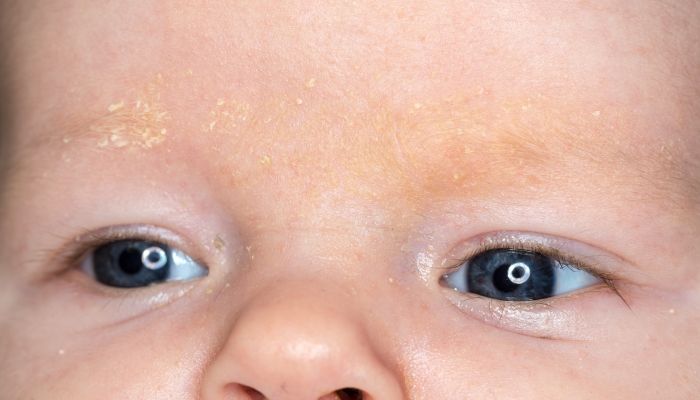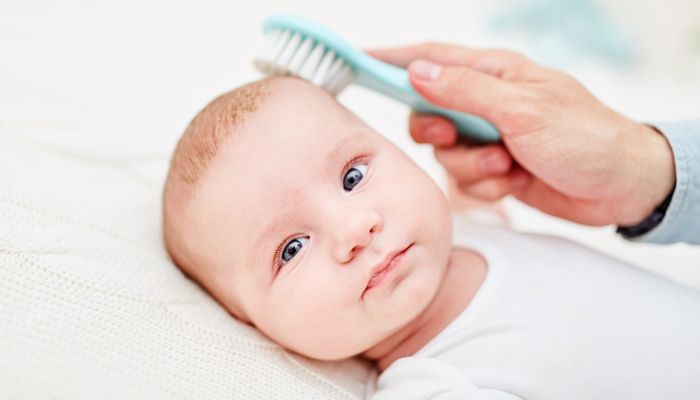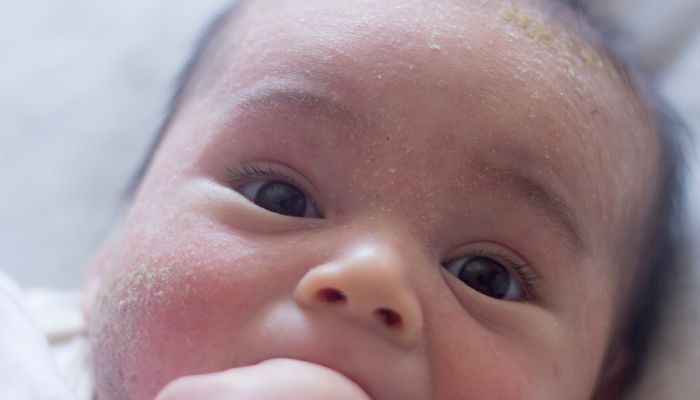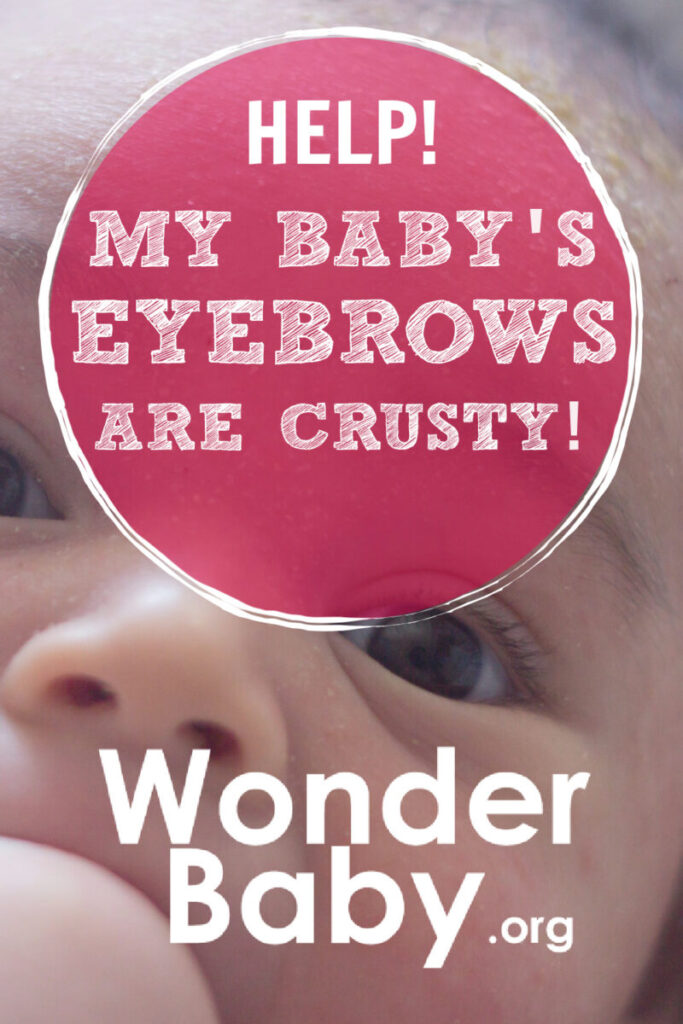Help! My Baby’s Eyebrows Are So Crusty!

This post may contain affiliate links; please see our terms of use for details.
- Cradle cap can affect any area where hair grows on your baby’s body.
- It’s incredibly common and affects around 10% of babies.
- It isn’t contagious and it won’t hurt, itch, or bother your baby.
Newborn babies are quite possibly the most gorgeous little things on earth. You could stare at their tiny toes, chubby thighs, and squishy cheeks all day. It’s the perfect time for pictures with excited family members, newborn photoshoots, and cuddly selfies. Unfortunately, it’s also the peak time for cradle cap to strike and can leave your baby’s eyebrows looking crusty and not so cute.
Happily, your baby won’t notice. The scales might look scary, but they’re not painful and don’t even itch. It’ll go away on its own, but there are also many easy treatment options if you want to speed things up and get your baby looking their best.
What is Cradle Cap?
Cradle cap, or seborrheic dermatitis, is a harmless and non-contagious skin condition that affects between 9 and 10% of children from birth to age four. It looks like yellowish, greasy scales on the skin’s surface and is most often found on your baby’s scalp, eyebrows, ears, and skin folds. While its appearance can be worrying, especially on your gorgeous baby’s face, rest assured it won’t cause them any discomfort or long-term effects.
Your baby is most likely to develop cradle cap in their first few months of life, and it’s most common at three months old. In most cases, cradle cap resolves by the time a baby turns one.
What Does Cap On the Eyebrows Look Like?
When cradle cap forms in eyebrows, it’ll make them look crusty, flaky, or scaly. The patches are usually yellow or slightly red and might seem quite greasy and waxy. Sometimes it’ll be limited to your little one’s eyebrows, but in more extreme cases it can cover their entire forehead.
Why Do Babies Get Cradle Cap On Their Eyebrows?
Cradle cap occurs when the oil glands in your baby’s skin become overactive and produce too much sebum. This means it’s usually found in the places on their body with the greatest number of these glands, such as the scalp and eyebrows.
The actual cause of this excess oil production still isn’t fully understood. Some scientists believe hormones, passed on from mom, might be responsible for oil glands overproducing sebum. It causes dead skin flakes to stick together, forming the scales. Others think that a type of yeast called Malassezia could be the true culprit. It’s also important to remember that cradle cap is not contagious, and it’s not related to poor hygiene. In other words, it’s not anyone’s fault!
How Can I Treat Eyebrow Cradle Cap?
Although cradle cap won’t bother your baby, it’s understandable to want to clear up their beautiful face. Cradle cap on the scalp can be hidden under a cute hat, but covering your little one’s eyebrows is a much harder task and they’re likely a few years away from decent bangs. Luckily, there are many treatment options available.
Washing
Since cradle cap is caused by excess oils, washing the affected area is very important. It’s recommended to use your baby’s regular, mild shampoo or soap and wash daily.
It can be tricky to wash the eyebrows without getting any shampoo in your baby’s eyes, so lay them flat and use a small amount on a damp washcloth. Wipe the scales gently and avoid scrubbing their skin. This method takes time, and it might be a few months before your baby’s face is picture perfect again.
Cradle Cap Shampoo
Special shampoo is available that’s been formulated for treating cradle cap. It’s designed to moisturize and help lift the flakes without clogging the oil glands. Be very careful around your baby’s eyes—it can be helpful to cover them with a clean, dry washcloth.

Oil and Brushing
While you might think that more oil is the last thing your baby needs, it’s actually a very effective and gentle way to lift the scales. The following steps should help to get their skin looking just as fresh as when they were born:
- Oil: Wipe your baby’s eyebrows with an oil like coconut, almond, or jojoba. Don’t be tempted to use olive oil as recent studies have shown it to be unsuitable for use on your baby’s skin. It’s always a good idea to test any oil by applying a small amount to healthy skin. Wait 24 hours to check for skin irritation or a rash.
- Wait: The longer you leave the oil, the more effective it’ll be. So, wait at least 15 minutes and consider leaving it overnight.
- Brush: Gently brush the scales away. You could use a regular soft-bristled baby brush, a new toothbrush, or a brush designed specifically for cradle cap. You should find that many scales will lift right off, but you’ll probably need to repeat the treatment a few times.
- Wash: Wash the oil away with mild soap to avoid further clogging the oil glands on your baby’s face.
What Not To Do
Pick the scales
Although it’s tempting, never try to remove the cradle cap scales by picking them off. This could cause an infection and, potentially, scarring.
If your baby starts picking at the scales, book an appointment with your pediatrician. They’ll want to check that it’s cradle cap since it shouldn’t be itchy. They might prescribe a cream to help clear it more quickly. While you wait to see a doctor, put your baby in scratch mitts or put socks on their hands to stop their scratching and prevent infection.
Avoid washing
It’s tempting to avoid washing as you might be worried about hurting your baby, and using soap near their eyes is risky. However, cradle cap should be washed every day since the excess oils need to be removed to prevent new scales from forming.
If you are considering using an over the counter cream be sure to consult with your doctor first. Creams designed for ringworm or athlete’s foot are not appropriate for treating cradle cap.
Could It Be Something Else?
Your baby’s skin is very sensitive and unfortunately, susceptible to many different skin problems. The following conditions are sometimes mistaken for cradle cap, so it’s a good idea to rule them out before treating.
- Eczema – Skin appears dry, cracked, itchy, and sore. It looks red on lighter skin and darker brown, purple, or grey on darker skin. Unlike cradle cap, eczema will cause your baby discomfort, itching, and might disturb their sleep.
- Psoriasis – A skin condition where new cells are formed too quickly and build up as flakes or scales. These are often red and white or silvery and can sometimes crack and bleed. Like with eczema, they differ from cradle cap in that they’re itchy and can bother your baby.
- Impetigo – A bacterial skin infection that causes a rash and fluid-filled blisters. It can be mistaken for cradle cap because once the blisters burst they form yellow scabs. It usually starts around the mouth but can spread to anywhere on your baby’s face or body.

When Should I See a Doctor?
If your little one’s cradle cap seems to be getting worse or isn’t responding to home treatment, there are medicated creams available that could help. It’s also worth checking with your doctor if the scales spread from your baby’s scalp to their face or body. Your doctor can check to make sure it’s not something else, like impetigo or eczema.
A pediatrician might prescribe an antifungal or a topical steroid cream for a couple of weeks. You should try to avoid extended use of steroid creams on your baby’s face, so make sure you’ve given another method at least a week to work first.
Keep an eye on cradle cap in the diaper area or skin folds (like eyelids or neck creases), as these areas are more likely to become irritated or infected.
It’s important to see a doctor if your child’s cradle cap:
- Starts to bleed or leak pus or other fluids.
- If the skin looks red, swollen, or feels warm (this could be a sign of infection).
- Covers their whole body.
- Isn’t getting any better after a few weeks of treatment.
- Lasts beyond 12 months.
- Causes your baby discomfort.
If you see any of this, it may have become infected and require a course of antibiotics.
FAQs
Can you use breastmilk for cradle cap?
Yes, breastmilk can be an excellent alternative treatment for cradle cap. It has antibacterial and anti-inflammatory properties which can prevent the cradle cap from becoming infected and promote healing. It’s also much easier to wash out of your baby’s hair than oil or creams.
Will cradle cap cause hair loss?
As you remove the flakes with a brush, some hair will probably come out too. This can be especially scary on their head and face. But don’t worry—it’s not permanent, and your baby’s hair and eyebrows will grow back unaffected.
Can cradle cap be cured?
There’s no cure for cradle cap. However, treatments like shampoo, oil, and creams will remove the flakes and keep them at bay until your baby grows out of it. Only 7% of children still have it after their first birthday and it’s incredibly rare after age four.
Which oil is best for treating cradle cap?
Natural oils like coconut, almond, and jojoba are often recommended for cradle cap. They are very kind to sensitive skin and can be used from birth. However, before use, you should perform a 24-hour patch test on an area of healthy skin to ensure that your baby isn’t allergic.
Whichever oil you choose, it should be free of added chemicals and perfumes. Check for words like “virgin” and “pure” since these are often additive-free. Always read the back of the bottle for ingredients just in case.
A great bonus is that once your baby’s eyebrow area is back to normal, you can continue using the oil for baby massages and any patches of dry skin.

The information WonderBaby provides is not intended to be, and does not constitute, medical or other health advice or diagnosis and should not be used as such. Always consult with a qualified medical professional about your specific circumstances.
Related Posts

Eye Conditions and Syndromes, Visual Impairment
Neuralink Announces Plans to Restore Sight to the Blind with Brain Chip
Elon Musk’s company Neuralink has announced plans to begin human trials of its new “Blindsight” brain chip by the end of 2025.

Health & Nutrition
Can Baby Skin Care Products Expire?
Is that forgotten tube of diaper rash cream still safe to use? Learn more about the expiration dates of popular skin care products for infants.

Health & Nutrition
Boosting Immunity in Kids: 3 Tips for a Healthy Winter
Parents can help boost their kids’ immunity during cold and flu season by maintaining healthy eating, sleeping, and exercising habits in the winter.